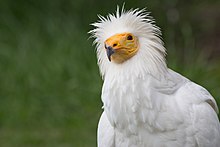Egyptian vulture
| Egyptian vulture | ||||||||||||
|---|---|---|---|---|---|---|---|---|---|---|---|---|

Egyptian vulture ( Neophron percnopterus ) |
||||||||||||
| Systematics | ||||||||||||
|
||||||||||||
| Scientific name | ||||||||||||
| Neophron percnopterus | ||||||||||||
| ( Linnaeus , 1758) |
The Egyptian vulture ( Neophron percnopterus ) is a bird of prey from the hawk family . It occurs from southern Europe to central Asia as well as in Africa and southern Asia. The Egyptian vulture is an occasional stray visitor in Central Europe, but the number of observations has been declining since the southern European populations fell so sharply.
Appearance
The Egyptian vulture's plumage is white with black wing feathers, which is particularly noticeable when in flight. In the throat area the feathers are yellowish. The head is featherless, wrinkled and bright yellow with sometimes an orange-red tinge, as is the base of the narrow beak , the tip of which is black. The feet are bright yellow like the beak. The iris is reddish brown. The tail is wedge-shaped.
The sexes cannot be distinguished in the plumage. However, males have a more intensely colored facial skin than the females. In young birds, the plumage is initially yellow-brown, somewhat spotted and becomes increasingly whiter from moult to moult until adulthood, around five years old . The fledgled face of the young birds is gray and the iris is black.
The size of an Egyptian vulture is 60–70 cm, its weight is between 1.5 and 2.2 kg, the wingspan is 1.65 m.
Way of life
Egyptian vultures live gregariously, but in small groups. In the savannah they are often only found in pairs. On the carcass , they are usually the last to get hold of a few chunks.
The brood takes place on rocks and cliffs at different heights, in holes or caves or under overhanging rock ledges to protect against the weather. Tree nests are very rare in this species. The nests are oversized for the size of the bird and appear untidy, especially since human waste can be woven between the branches, as well as bones, paper, rope ends. The nest is padded with soft materials and animal hair. Food residues from carrion brought in by both parents accumulate in the nest to the point of rot . The two white eggs with some brown spots are incubated by both partners for around 42 days. Young birds fledge at 80 days.
The basis of the food is carrion of all kinds, also dead small animals such as reptiles, fish, insects and other invertebrates are taken. Every now and then fruits are also eaten. In some places Egyptian vultures search rubbish dumps for something edible, occasionally human food waste, even human feces, are taken. In general, Egyptian vultures do not shy away from being close to humans and in some African villages they sit on the roofs of huts or on trees in the middle of the village. A specialty of this bird is the consumption of the contents of ostrich eggs. To break their hard shell, the birds use stones with an average weight of 50 g - but stones up to 500 g are also used. They may look for these stones far away from the ostrich clutch they have found, fly to the clutch with the stones in their beak and hurl the stones at the eggs until they shatter. After several attempts with a stone that is too light, they get a larger one. This behavior is a clear example of tool use in animals . They consume the liquid contents of the egg or the already well developed ostrich embryos on the spot.
distribution
The Egyptian vulture is found all over Africa , but is also found in temperate parts of Asia and Europe , especially in the Mediterranean area, and on the Cape Verde and Canary Islands . The population has recently increased in the Canary Islands; thanks to a protection plan, twelve percent more Egyptian vultures were registered in 2018 than in 2017. About 1,300 to 1,500 pairs live in Spain. In the rest of Europe there are around 1000 other pairs.
habitat
Dry tree and bush savannahs , only avoid desert areas and rainforests .
supporting documents
literature
- Hans-Günther Bauer, Einhard Bezzel and Wolfgang Fiedler (eds.): The compendium of birds in Central Europe: Everything about biology, endangerment and protection. Volume 1: Nonpasseriformes - non-sparrow birds. Aula-Verlag Wiebelsheim, Wiesbaden 2005, ISBN 3-89104-647-2 .
Web links
- Neophron percnopterus in the endangered Red List species the IUCN 2008. Posted by: BirdLife International, 2008. Accessed January 31 of 2009.
- Videos, photos and sound recordings for Neophron percnopterus in the Internet Bird Collection
- Age and gender characteristics (PDF; 5.6 MB) by J. Blasco-Zumeta and G.-M. Heinze (eng.)
- Photos at www.naturlichter.de
- Egyptian vulture's feathers
Individual evidence
- ↑ Bauer et al., P. 287
- ↑ Endangered species: Egyptian vulture population has grown in the Canaries , infos-grancanaria.com, February 10, 2019
- ↑ Walter Thiede: Birds of prey and owls - recognize and determine all species of Central Europe. BLV Buchverlag, Munich 2008, ISBN 978-3-8354-0448-9 .




